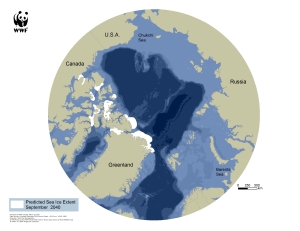This week, Arctic governments are meeting in Norway to talk about Arctic biodiversity. But they need to do more than talk. They’ve invested in reams of excellent research on life in the Arctic – now they need to act! They’ll make commitments this April, when the United States begins its chairmanship of the Arctic Council. Will they commit to Arctic action? This week, we look at #5ArcticActions nations can take to protect Arctic life:
Sea ice is the foundation of Arctic marine life. WWF’s Mette Frost is working to shape the future of a region where Arctic sea ice is likely to persist the longest – the Last Ice Area.
What is the Last Ice Area, and why is it important for Arctic life and livelihoods?
As the climate warms, Arctic sea ice is disappearing.
Almost every summer, the amount of remaining sea ice gets smaller. That summer sea ice is vitally important to a whole range of animals from tiny shrimp to vast bowhead whales, and to local people. One stretch of sea ice, along the northern coasts of Canada and Greenland, is projected to remain when all other large areas of summer sea ice are gone. This is the Last Ice Area.
WWF is supporting research on this vital Arctic habitat so Arctic people and governments can ensure life on the sea ice continues long into the future.
What can Greenland and Canada do in the next year?
We’d like to see them develop plans to establish a UNESCO World Heritage Site connecting Quttinirpaaq National Park in Nunavut with the National Park of North and East Greenland.
Are there lessons here for other Arctic states?
Unlike many of the ecosystems we work in, the Arctic is still relatively undeveloped. However, a warming climate means it’s opening up to industry very quickly. Arctic states have an opportunity to make smart conservation decisions now, before development happens, focusing on the areas that will be most resilient to climate change.
What can the public do?
- Learn more about the Last Ice Area
- Share this page
- Support conservation work in the Last Ice Area through Arctic Home
- Ask your politicians what their plans are to protect an area of remaining summer sea ice.

